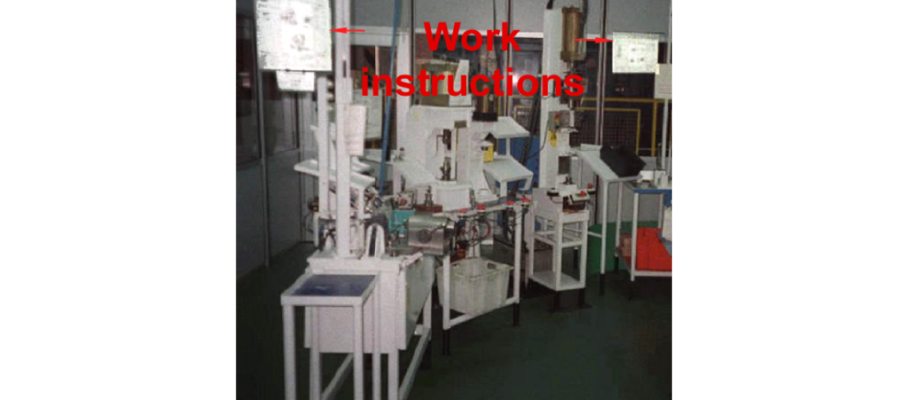Aug 3 2012
Lean Assembly available for the Kindle
Browsing through Amazon, I discovered that my own book Lean Assembly is now available for the Kindle. It is a welcome development, but I just wish they had told me.

Aug 3 2012
Browsing through Amazon, I discovered that my own book Lean Assembly is now available for the Kindle. It is a welcome development, but I just wish they had told me.
By Michel Baudin • Events 0 • Tags: Lean, Lean assembly, Lean implementation

Jul 20 2012
Kommersant is Russia’s main business newspaper; Tatarstan, a small republic in the Russian Federation, on the Volga river 620 miles East of Moscow, with a government that supports the implementation of Lean in the local industry. This interview is part of a 4-page section on Lean Manufacturing added for Tatarstan. They asked for my views on the status of Lean manufacturing implementation worldwide, the effect it has had on successful companies, the key elements required for implementation, the motivations of various companies undertaking it, and the ways government can or cannot help. What follows is the original English version, that was translated into Russian.
This interview is part of a 4-page section on Lean Manufacturing added for Tatarstan. They asked for my views on the status of Lean manufacturing implementation worldwide, the effect it has had on successful companies, the key elements required for implementation, the motivations of various companies undertaking it, and the ways government can or cannot help. What follows is the original English version, that was translated into Russian.
Mr. Baudin, you were in charge of Lean projects in many companies in different countries…
As a consultant, I am not in charge of projects. I am not Theodore Roosevelt‘s “man […] in the arena, whose face is marred by dust and sweat and blood; who strives valiantly; who errs, who comes short again and again, because there is no effort without error and shortcoming; but who does actually strive to do the deeds.”
This role, to whom credit belongs, is played by the VP of Manufacturing, Plant Manager, or Production Manager who own the processes that are the targets of improvement in Lean projects. My role is to be in their corner and help them be successful, but the credit and the glory is theirs.
How efficiently are Lean principles implemented there?
To date, very few companies have anything but a superficial veneer of Lean. For all the talk about “making Lean simple,” it just isn’t. What you see almost everywhere is what I call “Lean light”: a little bit of Lean sprinkled throughout the company, in the most visible places. It is just enough to get you certified as a “Lean supplier” by customer auditors, or even to get an award.
What are sights to behold are the few companies that implement Lean deep, making fundamental changes in the engineering of their production lines, their logistics, from the supply chain to in-plant part movements, the way they organize and use people, and the way they manage performance.
It is an enormous, multi-year effort, but what keeps them moving forward is that the benefits start accruing immediately.
What was the maximum effect from implementing Lean methods?
Industry dominance. This is what Toyota achieved, starting as a minuscule, nearly-bankrupt company in 1950 to become the Number 1 car manufacturer worldwide today. Because Lean is not easy, most managements give up early, creating opportunities for those who persevere. If you stick with it through the years, it gives you a durable competitive advantage.
Which company was able to achieve it?
There are a number of companies that are known for their success with Lean, like Autoliv, from Sweden, the Hon furniture company in the US, Valeo in France, or Porsche in Germany.
But I would rather speak of companies I have been personally involved with, even acknowledging that credit for their success redounds to their managers, engineers and operators, and not to any consultant.
The most successful one doesn’t want to advertize it, to the point that, if you google its name with Lean, nothing comes up. Without bragging about it, however, they have been at it since 1984. When I first visited them in 1987, they were a small to medium size maker of high-end mechanical parts outside the auto industry, with a few small plants in Europe and the US. When I last visited them about 20 years later, their sales were 10 times larger, and all their competitors from 1987 had become internal divisions.
To mention companies I can talk about, we also helped Renault of Argentina go from worst to best performer in the Renault group within four years. At the time, it was called CIADEA and had been sold by Renault to a prominent Argentinian businessman named Manuel Antelo. CIADEA was making Renault cars under license and was later sold back to Renault. I have stayed in touch with some managers involved at the time of our engagement, and they tell me that the high performance was sustained after we left.
By the late 1990s, the Japanese electronics manufacturer Canon was struggling to maintain its position largely because its production lines were not Lean. I worked with the US branch of Canon to introduce the cell concept in laser printer assembly. This was consistent with what Canon did elsewhere and, several years later, the top management of Canon credited the use of cells with restoring the position in the industry that it still holds. The Japanese electronics industry now actually uses the term “cell production” for Lean.
La-Z-Boy is an American armchair manufacturer that is also quite open about the success it has achieved through Lean, and in particular through cells. This was a short engagement for me but a major one for my colleague Kevin Hop, and we were both gratified with the outcome.
Is it possible to track a consistent pattern: is there a component of Lean without implementing which proper practical results are impossible?
It is usually a mistake to try to implement every Lean tool in a particular organization. What you should do in every case is analyze its business, technical and human situation, and deduce from it which kinds of projects make sense to undertake and in what sequence.
Eventually, all the dimensions of the business — engineering, logistics, organization, and performance — must be addressed in some form, but, for this purpose, not all of the existing tools of Lean may be relevant, and you may need to invent new ones.
How efficiently do you think is Lean implemented in Russia?
I would rather leave that question to colleagues who are living and working full time in Russia. I am based in the US and have come to Russia about a dozen times in the past 6 years. I have not seen a Russian plant I would consider a showcase of Lean, but then, I have not seen that many Russian plants.
In Tatarstan, Lean principles are implemented as a government program. But apparently it doesn’t always happen that way.
It actually rarely happens that way. I have nothing against government support for Lean, but it must be designed so that government officials are not put in a position to choose service providers for Lean implementation support, which is exactly what has happened in the US with the MEP (Manufacturing Extension Partnership) program. Through the National Institute of Standards and Technology (NIST), the federal government has been subsidizing consulting firms in all 50 states to provide services at reduced rates to small and medium-size entreprises (SMEs).
NIST is the agency in charge of standards for weights and measures, is run by managers who have never worked in factories, and is not competent to select Lean consultants. It is, however, exactly what NIST did, and, in so doing, created unfair competition to all other consultants.
What the government should have done instead is subsidize the SMEs directly, for them to select consultants, and pay market rates for services. Such a system would not have been perfect, and probably have led to some SME managers hiring their brothers in law with government money. This kind of risk is always present, but, at least, the choice of consultant would be made by the client, who understands his needs and the consultants’ capabilities better than a bureaucrat does, no matter how well intentioned.
What makes a company pursue Lean methods?
The two main motivations are (1) complying with external mandates and (2) improving their own performance. If a major customer of yours decides to buy only from “Lean suppliers,” it places on you the burden of proving to him that you qualify for this label, and it means satisfying auditors from your customer who may not know the first thing about your business and will come with a checklist. Then making sure you pass these audits is part of the cost of doing business. This motivation leads companies to strive to appear Lean, and success is measured in terms of obtaining the required certification. This is what leads companies to implement Lean-light.
If your motivation is improving performance, you will make different choices in your implementation plan, and you will go for Lean-deep, as explained above.
How important can government support be?
It can be necessary, but it must be limited in amount and temporary. Even from the beginning, support should not cover 100% of the implementation cost of the recipient companies, or else they are unlikely to implement anything. They should bear enough of the cost to want to recoup it through improvements. They should also stop needing support as they become successful.
Many CEOs of production associations in Tatarstan believe that Lean methods were used back in USSR as “scientific labor organization”. Do you agree?
And many American managers believe that Lean is nothing but warmed over Industrial Engineering or Fordism from 100 years ago. If soviet industry had been using Lean, it would have shown in its performance, and the whole world would have taken notice. The soviet union had a world-class industrial engineer in A. K. Gastev, and many outstanding inventors like Rostislav Alexeyev with his flying boats, or Alexander Kemurdzhian with Lunakhod. It even had Genrich Altshuller to develop a theory on how to invent (TRIZ). It just didn’t have Lean.
By Michel Baudin • Press clippings 0 • Tags: Government, Lean, Lean implementation, Lean manufacturing
Jul 10 2012
See on Scoop.it – lean manufacturing
Another thoughtful contribution from Larry Miller, with my comments.
See on www.lmmiller.com
By Michel Baudin • Blog clippings 0 • Tags: Lean, Lean implementation, Management

Jul 9 2012
Question 1: How to boil water?Answer 1: Take a pot, fill it up with water, place it on the stove, turn on the burner, and wait.Question 2: How to boil water, when you already have a pot of cold water on the stove?Answer 2: Empty the pot, put it away, and you are back to Question 1.
Instead of trying to develop and enforce a standard, one-size-fits-all methodology for all of a company’s plants — whose processes may range from metal foundry to final assembly — the corporate Lean group should instead focus on providing resources to help the plant teams develop their skills and learn from each other, but that is a different discussion.
When a production supervisor notices that an operator is not following the standard, it may mean that the operator needs to be coached, but it may also mean that the operator has found a better method that should be made the standard. But how do you make this kind of local initiative possible without jeopardizing the consistency of your process? The allowed scope for changes must be clear, and there must be a sign-off procedure in place to make them take effect.
I remember an auto parts plant in Mexico that had dedicated lines for each customer. Some of the customers demanded to approve any change to their production lines, even if it involved only moving two machines closer, but other customers left the auto parts maker free to rearrange their lines as they saw fit as long as the did not change what the machines did to the parts. Needless to say, these customers’ lines saw more improvement activity than the others.
In this case, the production teams could move the torque wrench closer to its point of use but they could not replace it with an ordinary ratchet and a homemade cheater bar. The boundary between what can be changed autonomously and what cannot is less clear in other contexts. In milling a part, for example, changing the sequence of cuts to reduce the tool’s air cutting time can be viewed a not changing the process but, if we are talking about deep cuts in an aerospace forging, stresses and warpage can be affected by cut sequencing.
If a production supervisor has the authority to make layout or work station design changes in his or her area of responsibility, it still must be done with the operators, and there are several support groups that must be consulted or informed. Safety has to bless it; Maintenance, to make sure that technicians still have the required access to equipment; Materials, to know where to deliver parts if that has changed. Even in the most flexible organizations, there has to be a minimum of formality in the implementation of changes. And it is more complex if the same product is made in more than one plant. In the best cases, when little or no investment is required, the changes are implemented first, by teams that include representations from all the stakeholders, and ratified later. We can move equipment on the basis of chalk marks on the floor, but, soon afterwards, the Facilities department must have up-to-date layouts.
The more authority is given to the local process owners, the easier it is to implement improvements, but also the more responsibility upper managers assume for decisions they didn’t make. The appropriate level of delegation varies as Lean implementation progresses. It starts with a few, closely monitored pilot projects; as the organization matures and develops more skills, the number of improvement projects explodes, and the local managers develop the capability to conduct them autonomously. At any time, for the upper managers, it is a question of which decisions pass the “sleep-at-night” test: what changes can they empower subordinates to make on their own and still sleep at night?
If there is a proven method today to document manufacturing processes in such a way that they are actually executed as specified, it is Training Within Industry (TWI). The story of TWI is beginning to be well-known. After being effective in World War II in the US, it was abandoned along with many wartime innovations in Manufacturing, but lived on at Toyota for the following 50 years before Toyota alumni like John Shook revived it in the US.
There are, however, two limitations to TWI, as originally developed:
The developers of TWI may simply have viewed revision management as a secondary, low-level clerical issue, and it may have been in their day. The pace of engineering changes and new product introduction, however, has picked up since then. In addition, in a Lean environment, changes in takt time every few months require you to regenerate Yamazumi and Work Combination charts, while Kaizen activity, in full swing, results in improvements made to thousands of operations at least every six months for each.
In many manufacturing organizations, the management of product and process documentation is slow, cumbersome, and error-prone, particularly when done manually. Today, Product Documentation Management (PDM) is a segment of the software industry addressing these issues. It is technically possible to keep all the standards, with their revision history, in a database and retrieve them as needed. The growth of PDM has not been driven by demands from the shop floor but by external mandates like the ISO-900x standards, but, whatever the reasons may be, these capabilities are today available to any manufacturing organization that chooses to use them.
Using software makes the flow of change requests more visible, eliminates the handling delays and losses associated with paper documents, allows multiple reviewers to work concurrently, but it does not solve the problem of the large number of changes that need to be reviewed, decided upon, and implemented.
This is a matter of management policies, to cover the following:
In principle, revision management can be applied to any document. In practice, it helps if the documents have a common structure. If they cover the same topics, and the data about each topic is always in the same place, then each reviewer can immediately find the items of interest. This means using templates, but also walking the fine line to avoid turning into DeMarco’s template zombies.
If you ask a committee of future reviewers to design an A3 form for project charters, it will be a collection of questions they would like answered. Accountants, for example, would like to quantify the financial benefits of projects before they even start, and Quality Assurance would like to know what reduction in defective rates to expect… Shop floor teams can struggle for days trying to answer questions for which they have no data yet, or that are put in a language with acronyms and abbreviations like IRR or DPMO that they don’t understand. More often than not, they end up filling out the forms with text that is unresponsive to the questions.
The teams and project leaders should only be asked to answer questions that they realistically can, such as:
The same thinking applies to work instructions. It takes a special talent to design them and fill them out so that they are concise but sufficiently detailed where it matters, and understood by the human beings whose activities they are supposed to direct.
It is also possible to display all instructions on the shop floor in electronic form. The key questions are whether it actually does the job better and whether it is cheaper. In the auto parts industry, instructions are usually posted in hardcopy; in computer assembly, they are displayed on screens. One might think that the computer industry is doing it to use what it sells, but there is a more compelling reason: while the auto parts industry will make the same product for four years or more, 90% of what the computer industry assembles is for products introduced within the past 12 months. While the auto parts industry many not justify the cost of placing monitors over each assembly station, what computer assemblers cannot afford is the cost and error rate of having people constantly post new hardcopy instructions.
In the auto industry, to provide quick and consistent initial training and for new product introduction in its worldwide, multilingual plants, Toyota has created a Global Production Center, which uses video and animation to teach. To this day, however, I do not believe that Toyota uses screens to post work instructions on the shop floor. In the assembly of downhole measurement instruments for oilfield services, Schlumberger in Rosharon, TX, is pioneering the use of iPads to display work instructions.
By Michel Baudin • Management 16 • Tags: Information systems, Information technology, Kaizen, Lean implementation, Quality, Standards, Training Within Industry, TWI
Aug 31 2012
Lean principles are saving Saskatchewan healthcare millions of dollars – News Talk 980 CJME
See on Scoop.it – lean manufacturing

Lean principles are saving Saskatchewan healthcare millions of dollarsNews Talk 980 CJMEThe government of Saskatchewan is boasting savings of some $60 million in the healthcare industry thanks to what they’re calling Lean concepts.
See on cjme.com
Share this:
Like this:
By Michel Baudin • Press clippings 0 • Tags: Health care, Lean implementation